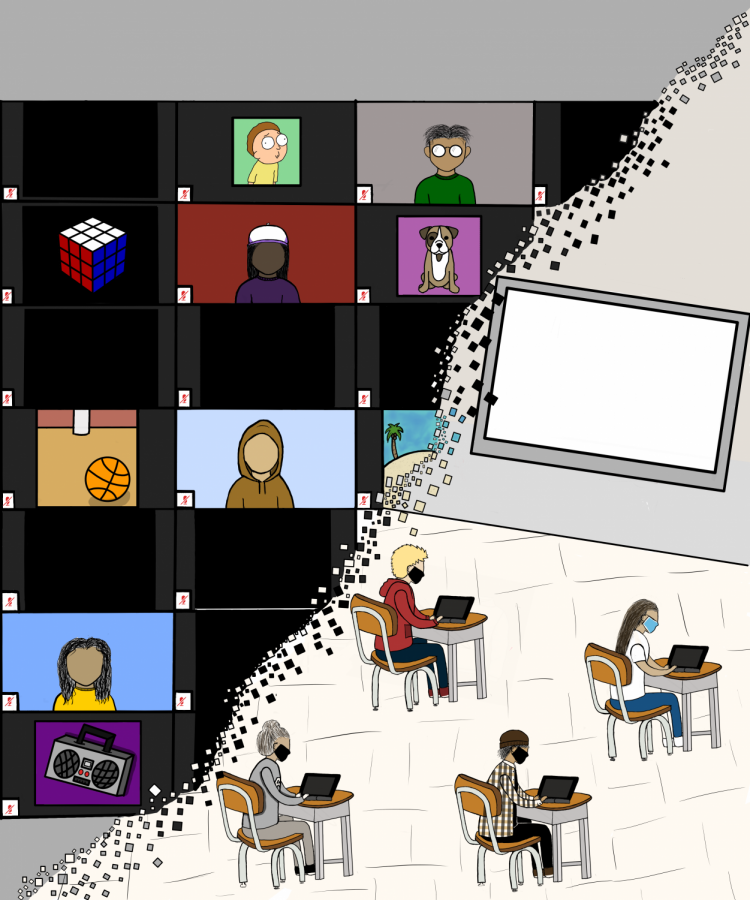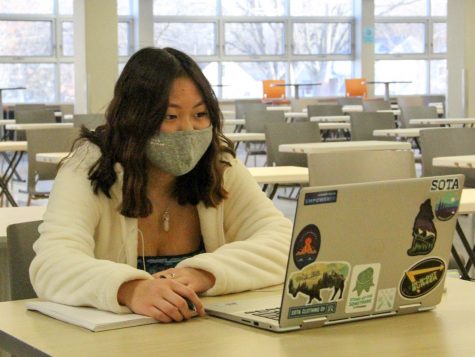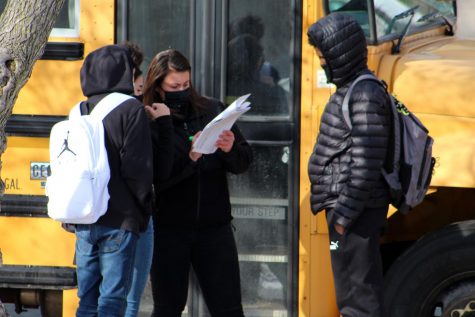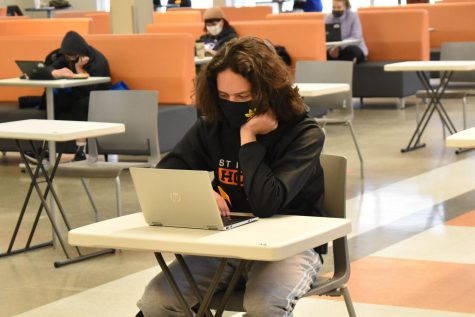Art by Jaida Puentes. Hybrid begins taking over Zoom calls. An unprecedented semester forced students to adjust their learning habits.
Semester in review, how did Park adapt?
Distance learning leaves some falling behind while others succeed
March 1, 2021
Struggling to stay afloat
Home used to be a place for junior Anna McCarthy to unwind after a long day. However, as a consequence of distance learning she must retreat to her room each day for school—a place of relaxation demoted to one of work.
“Working at home was really hard because that’s the place we used to go after a long day of school to relax, but now that’s just your life,” McCarthy said.
Students like McCarthy have struggled at home for a number of reasons including lack of motivation and in-person connections, as well as technology issues. Assistant Principal Jessica Busse said students struggle to find motivation in part because they don’t have a designated work area in their homes.
“I need to feel like I’m in my own workplace and have that disconnect of like at school, I do schoolwork and at home, I do home stuff,” Busse said. “That’s hard for kids to create, and also finding the motivation when you’re not constantly reminded of what homework is due, or what you should be working on.”
Along with some of her peers, senior Casey Hunter said she has struggled with keeping her grades up when she has little motivation to work.
“I’ve definitely had to work harder to maintain my grades,” Hunter said. “I did go on a streak of not having much motivation and they all kind of plummeted a little bit. Luckily, I found that motivation again (and) was able to get them back up, but it’s been like that for a few people too.”
Students have also struggled with gaining accessibility to internet, according to ninth grade counselor and Student Services department chair Barb Nelson. For some students, reliable internet is not always guaranteed at home.
“Many kids are living in apartment buildings where their internet is horrible. Even in my own house, I have five people on the internet on any day. I can be like in the middle of a call (and) it just goes out, so that’s definitely a big part of it,” Nelson said.
For students, the internet access was also a main factors in their grades due to the distractions that come along being online, according to Michelle Rennie, licensed marriage and family therapist.
“One of the things that I heard both from teachers and from parents, was the difficulty of having some kids on screen when they were supposed to be learning, the kids were savvy enough to know how to go play Roblox or Fortnight on a split screen,” Rennie said.
Busse said students have also missed the in-person bonds that are usually made between teachers and students in the classroom.
“We don’t have the relationships that we used to have, for the teachers who are just meeting kids for the first time it’s really hard, especially with cameras off and people not engaging, you don’t have the ability to make the relationships,” Busse said.
According to McCarthy, the lack of guidance and relations she has with her teachers has stressed her out.
“(It’s hard) not having a bond and connection with my teachers,” McCarthy said. “I don’t think (school) was ever easy for me, but now it really feels like it’s all on me, it’s all up to me and there’s less motivation.”
While Rennie said she acknowledges the difficulties that teachers and administrators face, she feels that many are falling behind because the classes have not been adjusted accordingly to help those students.
“I haven’t seen a lot of support given to kids who are struggling. It’s better than it was last spring. I think they’re better at scheduling, formatting,” Rennie said. “But in terms of really adapting lessons and curriculum online, I’m not really sure that happened.”
Support for struggling students
In an attempt to help students with faltering grades, Busse said she has taken multiple approaches to contact them, even going as far as showing up at their home.
“We’re trying all kinds of stuff. I’ve had kids in my office and I have had students that just need to come in and touch base, I call and text students and reach out on Instagram,” Busse said. “I’ve even gone so far as showing up on kids’ doorsteps to see what’s going on, so just anything that works, and it depends on the kid.”
One outlet offered to students has been the Oriole Study Nest, where students can join their classes while being in school surrounded by staff who can assist them. McCarthy, who has attended the Study Nest almost every day, said being in school eliminates the distractions that come with being at home.
“There are staff members checking in on you every once a while (making) sure you’re staying on track, and it’s just a different learning environment; my bed isn’t here so I can’t go take a nap and the kitchen isn’t here so I can’t go get food, I have to sit down and focus and I have peers here to encourage me to do the work,” McCarthy said.
Busse said out of all the strategies administration tried, she is most pleased by the Oriole Study Nest because it gives students a chance to control the space they learn in while getting all the assistance they need.
“It’s really given students the opportunity to create their own learning environment, which is really cool,” Busse said. “It’s something that I hope we can continue to do moving forward.”
According to Hunter, the Study Nest is beneficial not only because of the change in scenery but also because the school setting puts her in the appropriate headspace to do schoolwork. We’re doing our best and the sheer volume of kids with academic issues as well as mental health things all of the counselors and social workers are up to our eyeballs trying to manage meeting with students and helping support them. — Barb Nelson
“When you’re at school, not only are you in the school environment, there’s people around you also working on things. It just puts me in the mindset like ‘we’re here, we’re going to do work, we’re gonna get things done,’” Hunter said. “There (are) teachers there who are able to help me too and they’ve been really great about it. I think the school trying to make efforts to help students has been really good and I’m really glad that they’re doing it.”
While some students have taken advantage of the support offered by administration, some including freshman Modesty Manion have found ways to help themselves. For Manion, she combats her lack of motivation with a set daily routine.
“I try to get up early and change out of my pajamas so that I can tell myself it’s a new day, and I’m going to get work done, I’m going to be motivated,” Manion said.
Nelson said other strategies haven’t been as successful, as the virtual barrier makes it difficult for her to meet with struggling students.
“We’re reaching out but with the amount of times that kids don’t come, it’s just hard and I feel bad because there is no other way to contact them right now,” Nelson said. “We’re doing our best and the sheer volume of kids with academic issues as well as mental health things all of the counselors and social workers are up to our eyeballs trying to manage meeting with students and helping support them.”
According to Busse, there has been a lot of trial and error trying to find better ways to assist students and the administration is continuously learning how to help students best. She said one of the issues she is currently working on is drawing out the benefits and eliminating the disadvantages of asynchronous check-ins.
“There’s a lot of things that we’ve kind of struggled with and we keep trying new ways (to help students). Asynchronous check-ins, (which) I know kids hated but we actually got good results from, so how do we do asynchronous check-ins in a better way, that’s one of the areas that we’re kind of like tossing and turning over,” Busse said.
While many students are falling behind, Nelson said every teacher is doing the best they can to support their students.
“I know teachers are all working as hard as they can to try to help students and talk about ways to make things up and get their grades up,” Nelson said.
The outliers
While many students struggled this past semester, some actually improved their grades during distance learning, according to Nelson. She said many of those kids were those who struggled with the social aspect of school.
“(The students who succeeded) were probably a lot of those students who were distracted by what was going on in classes with peers, and also those kids that aren’t as comfortable socially in that environment of high school,” Nelson said. “So that environment (at home) where they can control and feel more comfortable doing that that’s been great for some of those kids that are like, ‘I can do this and I am able to manage things.’”
According to Rennie, many of the kids who excelled suffered from autism and other mental disabilities. She said distance learning served to their advantage as they had easier access to their teachers and were able to avoid some of the social barriers they faced in in-person learning.
“With online learning, they were able to communicate directly with their teachers. They are not being bullied as much, which had a direct impact on their learning,” Rennie said. “It’s important, looking at that population going forward (to see) what we can bring forward (after the pandemic).”
Busse said while many of the kids who are succeeding in distance learning do have trouble interacting with others in school, many kids are succeeding because they don’t have their peers to distract them. This is true for many students such as Manion, who said she gets her social interactions from sports, which allows her to focus on school while not feeling cooped up.
“When I’m at school and I’m around my friends, it can be kind of hard to focus, so when I’m at home I feel like there are less distractions, and with the breaks in between class I’m able to get more work done,” Manion said. “It’s also nice because I’m doing sports. I’m still able to see my friends so I still have that social aspect, but I’m just able to focus better.”
Both Manion and sophomore Henry Bendickson said their grades have held steady and they have had no struggles keeping up. According to Bendickson, he has seen his grades improve drastically as teachers have loosened up on due dates and workloads.
“I went from A’s and B’s to straight A’s,” Bendickson said. “I’ve got so much more time to study for tests. All the pressure has loosened, deadlines aren’t as strenuous.”
While everyone has experienced distance learning differently, many teachers and students are yearning to go back to in-person learning. According to Busse, she is looking forward to having students back in the building when hybrid learning starts Feb. 22.
“I can’t wait to have everybody back,” Busse said. “We just gotta do it safely, since we need everybody to be on board.”



